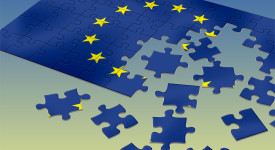The NATO summit in Brussels on 11-12 July is likely to be highly political. The Atlantic alliance is increasingly polarized due to disagreements over burden-sharing arrangements, national contributions and transatlantic solidarity, but NATO members cannot let these disagreements get in the way of addressing the ‘Russian challenge’ – the increasing tensions as Kremlin explores the boundaries of escalation with the alliance while trying to destabilize it. Prospects for improving relations with Moscow are minimal, especially in light of recent developments.
The latest meeting of the NATO–Russia Council on 31 May – the first since October 2017 – and the meeting between the chief of staff of the Russian armed forces and the chairman of the US Joint Chiefs of Staff on 8 June achieved very little. Since 2014, the alliance has adapted to focus on Russia’s actions in Eastern Europe, notably in the Baltic region and in Poland. But strengthening NATO’s eastern flank is not enough. Little has been done to work out a coherent vision for how to protect NATO interests in the Arctic or in the Black Sea. This is worrying since Russia is emboldened in both regions, as seen through brinksmanship such as provocative air maneuvering, an assertive force posture and constant military drilling.
In the Arctic and the High North, Russia has been increasing its military footprint there since 2014, through force and equipment deployment – notably by reopening military bases in northern Siberia and Novaya Zemlya, and on Franz-Josef Land – and more drills and patrols, including submarine activities. This has implications for trade routes and lines of communication between the Arctic and the North Atlantic. On the other hand, we have the Black Sea, where Moscow has been militarizing Crimea since its annexation in 2014 and the peninsula has been transformed into a military fortress.
Kremlin is also counting on disunity between NATO members which border the Black Sea, especially Turkey and Bulgaria. Both are playing an ambiguous game with Russia and their disagreements are an obstacle to strengthening NATO’s Black Sea presence. The most recent NATO deployment in October 2017 – a 4,000-strong multinational land, air and sea brigade-sized force based in Romania – has increased NATO’s presence on the Black Sea, though, by contrast, NATO lacks any comparable strategy for the High North. As NATO does not have a clear, united strategy for the Arctic or the Black Sea, both regions will face heightened risks as the Kremlin further builds up its military capabilities there.
NATO members should place the Arctic and the Black Sea high on the agenda and develop forces and capabilities to foster greater military mobility and situational awareness, including air policing missions, air and sea patrols and reconnaissance, anti-submarine warfare activities, air defense capabilities and coastal defense systems. For the Arctic, NATO needs to create a special Arctic task force either within NATO’s North Atlantic Council or as a stand-alone while it should also include non-NATO partners Finland and Sweden as well as relevant multilateral stakeholders such as the EU and the Arctic Council. Low tension in the Arctic region should remain a priority, while for the Black Sea, NATO should develop a stronger naval presence with Romania as a spearhead and attempt to get compliance from Turkey and Bulgaria.
‘NATO Needs a Strategy for Countering Russia in the Arctic and the Black Sea’ – Commentary by Mathieu Boulègue – Chatham House / The Royal Institute of International Affairs.







